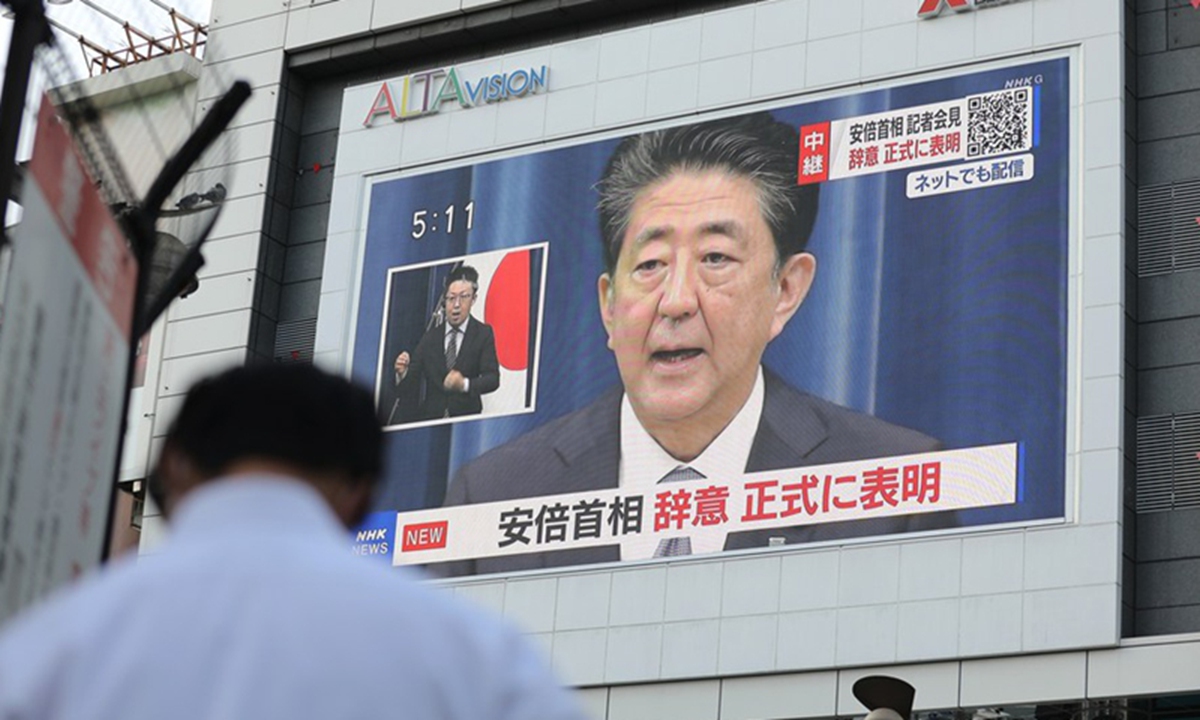As Abe steps down, did Abenomics succeed?
By Erik Norland Source: Global Times Published: 2020/10/28 15:17:23

An electronic screen shows that Shinzo Abe speaks at a press conference in Tokyo, Japan, on August 28, 2020. Photo: Xinhua
Former Prime Minister Shinzo Abe's resignation could significantly alter Japan's economic policies. When Abe took the reins in December 2012, the economy was beset by three intertwined problems: large annual budget deficits; persistent deflation, which made reducing debt ratios nearly impossible; and weak economic growth since Japan's equity and real estate bubbles popped in the early 1990s.Abe sought to address these problems with his "three arrows" initiative of eased monetary policy, tight fiscal policy, and structural reform. Over the past eight years Abe's policies have had some success. For starters, nominal GDP had its first sustained period of growth since the mid-1990s, lasting until late 2019 when a second increase in value added tax (VAT) and the pandemic intervened.
Prior to Abe taking office at the end of 2012, Japan ran enormous budget deficits since the mid-1990s. Japan's public debt rose from 62 percent of GDP in 1992 to 201 percent by the beginning of 2013. Japan's government spending as a percentage of GDP was not particularly high by the standards of most developed countries but its tax revenues were extremely low. Abe addressed the low level of tax revenues through two increases in VAT. This and other revenue measures, along with improved economic growth, reduced Japan's pre-Abe budget deficit from 6-8 percent of GDP to just 2.8 percent by 2019.
As a result of the pandemic, Japan's budget deficit and debt ratios have risen once again in 2020. So far, Japan has allocated the equivalent of 7 percent of GDP to boost the economy amid the pandemic and has extended loans to corporations and households valued at more than 10 percent of GDP. As a result, Japan's budget deficit for the fiscal year ending in March 2021 will probably fall in the 12-22 percent of GDP range, and possibly more. This, however, hardly makes Japan unique as similar deficits will occur in the US and in much of Western Europe.
Abenomics's ultimate objective was to improve the Japanese economy. Tighter fiscal policy, while necessary for controlling budget deficits, is antithetical to that goal. Essentially, tighter fiscal policy could potentially have derailed growth had it not been for eased monetary policy.
When Abe took office in 2012, the Bank of Japan's (BoJ) monetary policy was unexceptional. Like the Federal Reserve (Fed), it had rates at zero and had dabbled in quantitative easing (QE). The main difference with the Fed was one of timing: The BoJ's rate had hit zero a decade before that of the Fed, and it had conducted some QE between 2000 and 2006 and again between 2010 and 2012 when the Fed was just getting started on its own asset purchases. But at 30 percent of GDP, the BoJ's balance sheet wasn't particularly large. It was about the same as that of the European Central Bank (ECB) and about 1.5x that of the Fed relative to the size of their respective economies.
In order to offset the fiscal consolidation, the BoJ opted for QE of unprecedented size and depth that dwarfed similar measures in Europe and North America. The BoJ took its balance sheet from 30 percent of GDP to over 100 percent of GDP prior to the pandemic. Now it's surpassing 125 percent of GDP.
In addition to the QE measures, the BoJ also conducted yield curve targeting, essentially setting caps on the yields of various maturities of government bonds. Finally, like the ECB but unlike the Fed, it also experimented with negative interest rates, setting its deposit rate at -10 basis points (bps) as of January 29, 2016.
So, have these measures worked? On balance it's difficult to say. Looking at Japan's nominal GDP, it looks like a success. Nominal GDP expanded from early 2013 until mid-2019, which is essential for controlling debt ratios since nominal GDP is the denominator in the calculation of those ratios. Real GDP, meaning after inflation, tells a more nuanced story. Judging from the graph of real GDP, it's difficult to point to any acceleration in Japan's after-inflation pace of economic growth.
While QE did not give any obvious boost to Japan's real rate of growth, it did halt persistent deflation with the help of depreciation in the trade weighted value of the Japanese yen between early 2013 and early 2016. Paradoxically, the BoJ's resorting to negative rates did not cause the yen to fall further. Rather, in the four-and-a-half years since the BoJ instituted negative deposit rates, the yen has appreciated somewhat. In the year after the decision to go to negative rates, the yen began to rise and inflation regressed into deflation before eventually going positive again.
By at least one measure, Abenomics has been a success: Japan's jobs market improved markedly until the pandemic struck, with the best jobs-to-applicant ratio seen in decades.
The author is senior economist at Chicago Mercantile Exchange CME Group bizopinion@globaltimes.com.cn
Posted in: EXPERT ASSESSMENT